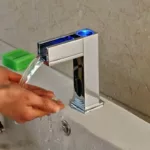It can be very annoying and intimidating when an inanimate object tries to disgrace you in the public. Yeah, you can say the same for motion sensor faucets, also known as touchless faucets. When you think you understand the hack based on previous usage, you can find yourself in a public bathroom or as a guest in a home and you realize that the faucet isn’t dispensing water to you. Well, there is no real big deal. It is all about trying to understand how these motion sensor faucets work.
Motion sensor faucets have four main operational components that include:
Sensor: Either motion detectors or presence sensors, a typical motion sensor faucet has one of these, which triggers another part to let out water. The sensor detects an infrared signal before triggering the responsible mechanism for water release. It is often hidden behind a dark screen. Depending on the type of faucet, you can have the sensor close to the lip of the spout, at the base, or on the stem.
Spout: A spout holds every working part of a faucet. It comes in different designs, styles, and colors, depending on the manufacturer.
Solenoid valve: This is the actual part of a motion sensor faucet that controls water flow. It is an electromagnetic diaphragm that is pushed or pulled according to the electric polarity that is sensed. Once it receives a signal from the sensor about the presence of a hand, it contracts/pull, allowing water to flow and vise versa.
Power source: The power source includes a panel where electric current can be generated. Hence, the panel allows battery options like AAA, C, or any other one according to the design of the manufacturer.
After knowing the basics about the various parts of a motion sensor faucet, now, let us look at 5 operational tips about them.
1. Locate the sensor: This is the first thing to do. They are often dark colored lens and you can check the parts of the spout where they are placed (as discussed above). Once you locate it, place your palm just slightly under. There, you would have the flow.
2. Don’t forget the principle of reflection: Infrared rays are needed to activate the solenoid valve, so, place your hand in a way that it can properly reflect the rays to the sensor.
3. For short flows, repeat: Some of these faucets were designed to let out water for a number of seconds and they stop. This can be to control water usage. However, if that is your case, simply remove your hand and place it before the sensor again.
4. Get closer: Some of these motion sensor faucets are short ranged, but you never can tell which is or not. So, move your hand close enough to be detected and allow a flow.
5. It might not work: If you have tried all these and nothing comes out, look at the sink or wash-hand basin for traces of water. If nothing is seen, then it means it is not working. Just move on to the next sink.








